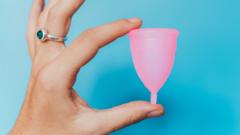Doctors are raising alarms about the risks associated with improperly used menstrual cups after a reported case where a woman experienced temporary kidney problems. The patient, in her 30s, had been facing symptoms like intermittent pelvic pain and blood in her urine but was unaware that her menstrual cup's misalignment was the cause. According to a study published in the British Medical Journal, it's rare, but a wrongly positioned cup can exert pressure on nearby structures, including ureters that transport urine to the bladder.
Medical professionals emphasize the necessity of selecting the appropriate cup size and ensuring proper insertion to mitigate risks to the urinary tract. Although menstrual cups are widely available without professional guidance, doctors stress the need for comprehensive user information.
Menstrual cups are a popular, eco-friendly alternative to traditional sanitary products, made from malleable materials such as silicone. They can hold 20 to 30 ml of menstrual fluid and can be reused throughout the day, requiring removal and cleaning every four to eight hours.
First-time users often struggle with removal; a recent survey highlighted that many young women faced challenges during their initial attempts. Health experts recommend breaking the suction seal before removal and suggest that adjusting to using a menstrual cup may take several cycles. Dr. Kate Lough, a pelvic health physiotherapist, reassures that these products are generally safe when used correctly.
Different shapes, sizes, and firmness levels make it pivotal for users to find a cup that fits well. Caution is advised for those who have had a contraceptive coil inserted, as there's a slight chance of it shifting during cup usage. Users should consult healthcare professionals if they suspect any complications. Menstrual discs, similar to cups, are another option, designed to sit higher in the vaginal canal.



















